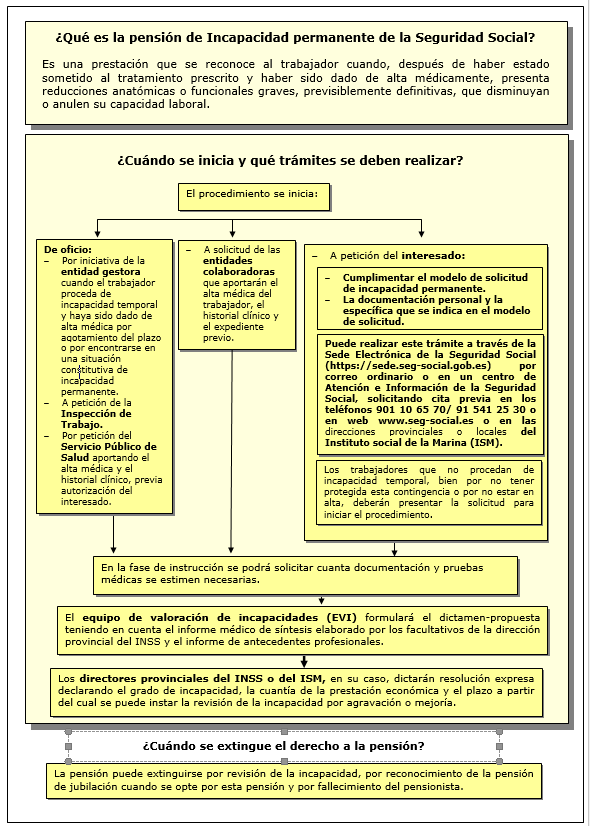Pensión de Incapacidad Permanente
Procedimiento
Información General
| Objeto: |
Es una prestación económica que trata de cubrir la pérdida de ingresos que sufre un trabajador cuando por enfermedad o accidente ve reducida o anulada su capacidad laboral. |
|---|---|
| Beneficiarios: |
Las personas incluidas en cualquier régimen de la Seguridad Social que reúnan los requisitos exigidos para cada grado de incapacidad. |
| Grados: |
|
| Requisitos: |
Dependiendo del grado de incapacidad, se exigen unos requisitos generales y de cotización. Si la incapacidad deriva de accidente sea o no de trabajo o de enfermedad profesional no se exigen cotizaciones previas. |
| Cuantía: |
Está determinada por la base reguladora y el porcentaje que se aplica según el grado de incapacidad permanente reconocido.
|
| Efectos económicos: |
|
| Pagos: |
Cuando la pensión deriva de enfermedad común o accidente no laboral se abona en 14 pagas (mensualmente con dos pagas extraordinarias). Se revaloriza anualmente y tiene garantizadas cuantías mínimas mensuales. La pensión está sujeta al impuesto sobre la renta de las personas físicas (IRPF), estando exentas de retención del impuesto, las pensiones por incapacidad permanente absoluta y gran incapacidad. |
| Compatibilidades / Incompatibilidades: |
En todos los casos, si se realizan trabajos susceptibles de inclusión en alguno de los regímenes de la Seguridad Social, existe obligación de cursar el alta y cotizar, debiendo comunicarlo a la entidad gestora. |
| Plazos: |
La dirección provincial del INSS o del ISM, en su caso, dictará resolución en un plazo máximo de 135 días. Cuando no se dicte resolución en ese plazo se entenderá desestimada la solicitud por silencio administrativo negativo. Si es necesario el trámite de audiencia o se pide documentación complementaria, el interesado dispondrá de 10 días para presentar alegaciones o presentar la documentación. También 10 días para alegaciones del empresario cuando es responsable por falta de medidas de seguridad e higiene. |
| Suspensión / Extinción: |
La pensión puede extinguirse por revisión de la incapacidad declarada, por reconocimiento de la pensión de jubilación cuando se opte por la misma y por fallecimiento del pensionista. También puede ser suspendida. |
| Impresos: | |
| Documentación: |
La documentación que debe presentar para el trámite de la pensión está detallada en el modelo de solicitud. |
| Dónde se tramita: |
En la dirección provincial del INSS o del ISM, en su caso, donde tenga su domicilio el interesado, excepto cuando resida en el extranjero que el trámite se realizará en la dirección provincial del INSS de la provincia donde acredite las últimas cotizaciones en España. En caso de ser competente el ISM, se estará a la distribución territorial de éste. |
| Entidad competente: |
|
| Otros datos de interés: |
Revisión: La situación de incapacidad puede revisarse por agravación, mejoría, error de diagnóstico o por la realización de trabajos, mientras el inválido no haya cumplido la edad de acceso a la jubilación, pudiendo dar lugar a la confirmación o modificación del grado o a la extinción de la incapacidad y por tanto de la pensión. Las pensiones de incapacidad permanente pasan a denominarse pensiones de jubilación, cuando sus beneficiarios cumplen 65 años. En Cataluña las funciones de los EVI, las realiza el Instituto Catalán de Evaluación de Incapacidades y la Comisión de Evaluación de Incapacidades. |

 Inicio
Inicio